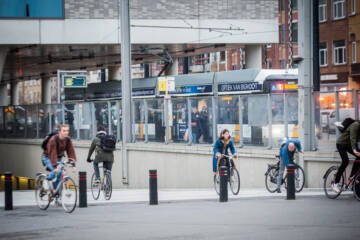Mobility hubs: crucial switches for tomorrow’s smart mobility

Smart mobility requires – amongst many other factors – a dense network of ‘mobility hubs’, where people can easily switch between transportation modes. But to make these hubs attractive enough to generate a real impact on the current mobility, environmental and spatial challenges, they will have to be much more than that.
Smart mobility requires – amongst many other factors – a dense network of ‘mobility hubs’, where people can easily switch between transportation modes. But to make these hubs attractive enough to generate a real impact on the current mobility, environmental and spatial challenges, they will have to be much more than that.
Smart mobility requires – amongst many other factors – a dense network of ‘mobility hubs’, where people can easily switch between transportation modes. But to make these hubs attractive enough to generate a real impact on the current mobility, environmental and spatial challenges, they will have to be much more than that. How do we design hubs in line with needs of both users and neighbours? And what opportunities do hubs bring for businesses? Fasten your seatbelts, as Living Tomorrow tackles the challenges and solutions.
Smart Mobility starts from the idea that you can travel smoothly from your doorstep to your destination, by using just the right means tailored to your journey and your travel preferences. The backbone of such a system are mobility hubs or ‘nodes’, where you can switch from train to tram or bus, taxi, a shared car, bike, scooter or step. But they may also offer flexible workplaces, fitness and food amenities, e-commerce collections points... So what does this mean for hubs’ design, layout and roll-out?
Shared mobility: minds are maturing
Research shows that 50% of all cars travel less than 10.000 kms per year. Many don’t leave the garage for days in a row. Likewise, an interesting fact is that in the last decade, driving licenses issued in Belgium dropped by 30%. The younger generation clearly considers a privately owned car more a burden than a benefit, much less a status symbol. But they might use a shared car now and then for destinations hard to reach by public transport or bike. So why not turn parking spaces of businesses in or near residential areas - after office hours - into charging and parking spots for shared cars of the neighbourhood?
This is just one example of how EV sharing brings huge opportunities for businesses in multiple ways. It can generate visitor traffic to their site to showcase products and services. Rethinking business infrastructure in relation to the local population and surroundings opens the opportunity for offering a new service and generating additional revenue. Also, it is an asset for employees rethinking their mobility footprint. Last but not least, local authorities are crucial to act as the facilitator of EV mobility and will be happy when one creates extra room for redesigning public space for people to meet, park and share vehicles and experience the city.
Micro mobility: ‘bicycle first’ in the 15-minute city
If ‘short distance = bicycle’ becomes the lead principle, we must also rethink and redesign road infrastructure and public space, such as one-way streets with wide pavements. Access to micro mobility options - bicycles, e-scooters, and mopeds - will be vital to provide a convenient, affordable and safe transit-oriented urban hub system. Sharing systems are no doubt crucial, but need to be tailored to the urban or non-urban context. If you want people to live in the city, you have to get people easily from the centre to nature to relax and rewind.
Therefore mobility hubs will only be successful if they are close to the users’ home to start and end their journey. Hence the ‘15-minute city’ idea, which is based on research by Professor Carlos Moreno at the Sorbonne in Paris. The concept is one in which daily urban necessities are within a 15-minute reach on foot or by bike. Work, home, shops, entertainment, education and healthcare — in Moreno’s vision, these should all be available within the same time a commuter might once have waited on a railway platform.
Different drives and drivers
Another lever for smart mobility is policy vision. Flanders is shifting from a supply-driven to a demand-driven concept of public transport in combination with the rollout of a dense network of so-called “Hoppin” nodes to switch between different transport modes. Public transport no longer aims to reach every corner of the region, but serves as one of many networks and transportation options, including micro-mobility and sharing options.
Again that creates opportunities for businesses and cities to rethink their use of infrastructure and space. The site of Living Tomorrow in Vilvoorde will become such a Hoppin point, spanning from Brussels airport to the Brussels city centre showcasing a ‘floating’ bicycle highway and the ‘Ringtrambus’. The new Innovation campus Living Tomorrow 2030 will also offer visitors super-fast charging infrastructure and innovative meeting formulas to appeal to various target groups.
So, what will mobility hubs look like?
There’s no way back: our good old service stations will have to reinvent themselves too. Actually they are already doing that, joining forces with various suppliers of extra services. Fuel retailers need to move from a vehicle-centric to a customer-centric business model, and develop a corresponding response regarding products, services and the layout of stations and convenience stores, embracing new digital tools and acting as logistical service point for e-commerce.
The conclusion of all these trends is that mobility hubs can take many shapes. They may vary in size, type of location, and service offering. They can be small and located in residential areas, with just one or two parking spots, or much bigger and positioned nearby major public transport interchanges. It can be gas station, or a car park on a business site. In the end, the key is that they should always be where supply and demand meet and help to dissuade citizens from owning private cars, resulting in cleaner, more liveable and pleasant cities.
Latest insights & stories

ROAD SAFETY
Since 2018, the number of traffic casualties in Flanders has risen again. Currently, the figures are stagnating, but the risk of accidents with injuries remains high for vulnerable road users in Flanders. And that while traffic should be safe for all users and modes. We want to change this by focusing on transparent policy, training on safe behavior, infrastructure improvements, legislation and enforcement.

What is needed for a more circular construction sector? Insights from Sien Cornillie, Circularity expert at NAV
NAV, or "Netwerk Architecten Vlaanderen," is a professional organisation for architects in Flanders. It offers various services including professional development and advocacy for the architectural sector. NAV also fosters networking opportunities and provides advice on legal, technical, and management aspects. The network is currently working on a position paper on circularity. We sat down with Sien Cornillie, an expert on circularity and energy at NAV. This interview reflects her own opinion.

A Global Movement: The World Unites in a Pink Pledge for Clean and Sustainable Water
5,000 participants. 32 countries. €30,000 funds raised. And that's just the beginning.
Picture this: One step that sends ripples across the globe, transforming lives and creating waves of change. You might wonder, how can such a simple action for most of us have such a profound impact?